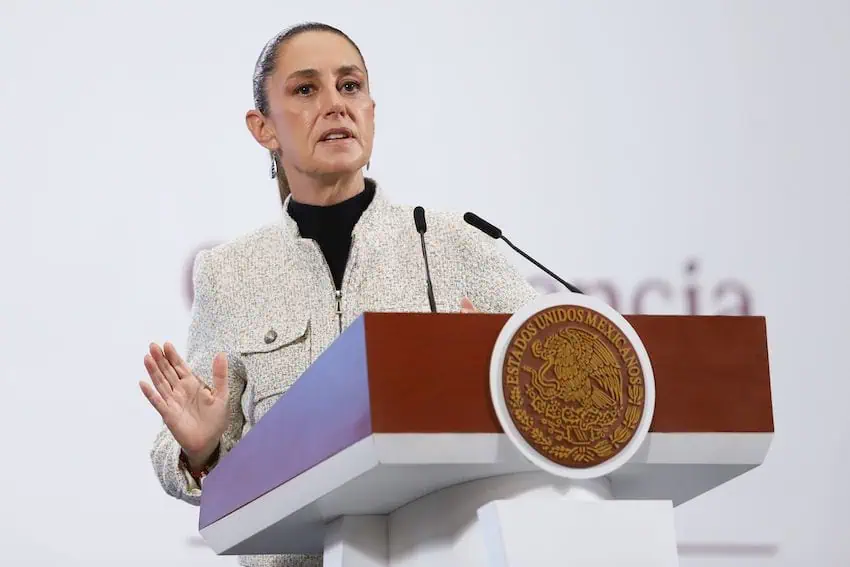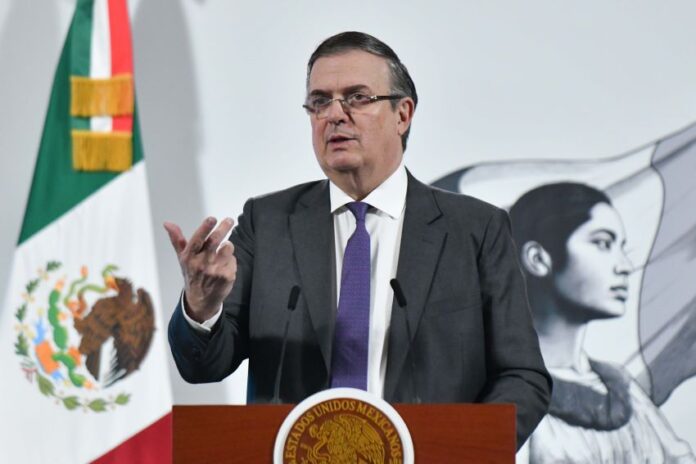Economy Minister Marcelo Ebrard said Tuesday that the Mexican government has made every possible effort to stave off the 30% tariff the United States intends to impose on imports from Mexico starting this Friday.
He expressed optimism that Mexico will reach a deal with its northern neighbor to stop the duty from taking effect.
🚨 Trump se mantiene firme
Los aranceles del 30% entran en vigor el viernes.
“Ya todo lo que México tenía que hacer está hecho. Ahora tenemos que esperar”, decía Ebrard ayer.pic.twitter.com/UNFZhqs4vA
— Manuel Lopez San Martin (@MLopezSanMartin) July 30, 2025
“[The negotiations] have been very intense, complex. We’re hours away from knowing how this stage will conclude. My perspective is optimistic, but we have to wait for the decisions President Trump takes with his team,” Ebrard said at a press conference.
“Everything that Mexico had to do is already done,” he said.
Ebrard said that “the results” of Mexico’s negotiations with the United States over the 30% tariff will be known on Friday.
The Mexican government has spent much of 2025 attempting to negotiate relief from tariffs imposed by Donald Trump.
The latest trade negotiations came after the U.S. president informed President Claudia Sheinbaum in a July 11 letter that the United States, starting Aug. 1, would “charge Mexico a tariff of 30% on Mexican products sent into the United States, separate from all sectoral tariffs.”
US announces 30% tariff on Mexican goods as bilateral talks continue
Trump didn’t specify whether the 30% tariff would be added to — or replace — the existing 25% tariff that applies to Mexican goods that don’t comply with the USMCA free trade agreement.
Although the U.S. president appeared to imply that all Mexican goods would be subject to the 30% tariff, a common interpretation of his letter was that the new duty would only apply to non-USMCA compliant products, and would increase the current rate by five percentage points.
“The market so far has interpreted that the new tariff on Mexico represents only a marginal change from the status quo,” Ernesto Revilla, managing director and head of Latin America economics at Citigroup, wrote in Americas Quarterly on July 14.
“That is, it is a five-percentage-point increase in a tariff that applies to less than 20% of total trade between Mexico and the U.S. that is non-USMCA compliant,” he said.
The United States has not publicly clarified whether the 30% tariff will apply to all imports from Mexico or just those that don’t comply with the USMCA. However, an unnamed White House official told The New York Times that the exemption for USMCA-compliant goods would most likely continue.
“The official also said the 30 percent rate would replace the previous 25 percent levies that Mr. Trump imposed on the country,” the Times reported.
Trump explained the rationale for the 30% tariff in his letter to Sheinbaum.
“Despite our strong relationship, you will recall, the United States imposed tariffs on Mexico to deal with our nation’s fentanyl crisis, which is caused, in part, by Mexico’s failure to stop the cartels, who are made up of the most despicable people who have ever walked the earth, from pouring these drugs into our country. Mexico has been helping me secure the border, BUT, what Mexico has done, is not enough,” he wrote.
“Mexico still has not stopped the cartels who are trying to turn all of North America into a narco-trafficking playground. Obviously, I cannot let that happen!” Trump said.
Despite United States Commerce Secretary Howard Lutnick saying on Sunday that there would be “no extensions” or “grace periods” for U.S trade partners, Sheinbaum has also expressed optimism that Mexico will reach a deal to ward off the 30% tariff. She said last Thursday that her government was doing everything it could to stop the new duty from taking effect.
“There is a team working in the United States with the [U.S.] commerce secretary and the treasury secretary,” Sheinbaum told her morning press conference on Thursday.

“We made a series of proposals that have to do with Plan México and also reducing the trade deficit [with the United States], which is one of the concerns of President Trump,” she said.
“The trade deficit can be reduced through different mechanisms that don’t affect the economy of Mexico. So we’ve been making a series of proposals and we’ll present them here [at a later time], hoping that we reach an agreement.”
Sheinbaum also pointed out that fentanyl seizures at the Mexico-U.S. border have significantly declined since she took office last October.
What US tariffs currently apply to imports from Mexico?
These are the tariffs that are currently in effect for imports from Mexico.
- Tariffs of 25% apply to all Mexican goods that don’t comply with the USMCA free trade pact. These tariffs took effect on March 4 when the United States imposed 25% duties on all imports from Mexico. Trump suspended tariffs on imports from Mexico covered by the USMCA free trade pact on March 6.
- Tariffs of 50% apply to Mexican steel and aluminum and hundreds of products made with those metals. The United States imposed a 25% tariff on steel and aluminum in March and increased the rate to 50% in June.
- Tariffs on vehicles made in Mexico have been in effect since April 3. The United States imposed 25% tariffs on all vehicle imports on this date, but U.S. content in vehicles assembled in Mexico is exempt from the duty, lowering the effective tariff on vehicles made in Mexico.
- Auto parts made in Mexico that don’t comply with USMCA rules have been subject to a 25% tariff since May. The vast majority of auto parts made in Mexico do comply with the USMCA and are therefore exempt from the tariff.
- Fresh tomatoes from Mexico have faced a tariff of around 17% when entering the United States since July 14 after the U.S. withdrew from a 2019 agreement with Mexico that suspended an antidumping duty investigation.
More than 80% of Mexico’s trade with US is tariff-free, says Ebrard
Although the United States currently imposes a range of tariffs on imports from Mexico, Ebrard said that 84% of Mexico’s trade with its northern neighbor complies with the USMCA and is therefore tariff-free.
The economy minister asserted that Mexico is in a good position in its trade relationship with the United States “if you compare the country’s situation to the rest of the world.”
Mexico was the top exporter to the United States in 2023 and 2024, and Ebrard asserted that it will retain that position “despite the tariffs.”
With reports from El Economista, El Financiero and Reforma
